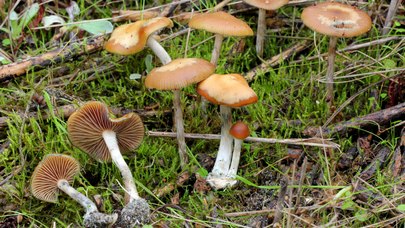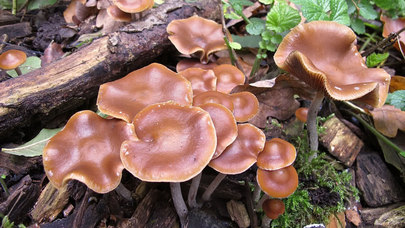Psilocybe cyanescens
Description
Psilocybe cyanescens, like all mushrooms of the Psilocybe genus, have a hygrophanous nature, meaning their coloration shifts depending on hydration levels. They turn a cyan bluish color when handled or bruised, due to the oxidization of psilocin. The underside of the pileus is densely gilled, and they possess a thin gelatinous veil (pellicle) separating the pileus and stipe.
The main compounds responsible for its psychedelic effects are psilocybin and psilocin. It belongs to the family Hymenogastraceae. The mushroom is not generally regarded as being physically dangerous to adults. Since all the psychoactive compounds in P. cyanescens are water-soluble, the fruiting bodies can be rendered non-psychoactive through parboiling, allowing their culinary use. However, since most people find them overly bitter and they are too small to have great nutritive value, this is not frequently done.
Psilocybe cyanescens is primarily a wood-chip dweller, being found in much the same locales as Stropharia aurantiaca and, like the latter species, becoming increasingly common, much to the delight of magic mushroom hunters. Normally it does not appear until relatively late in the season, typically around Halloween with the onset of cold weather.
Psilocybe cyanescens can sometimes fruit in colossal quantity; more than 100,000 mushrooms were found growing in a single patch at a racetrack in England.
Common names: Blueleg Brownie, Cyans, Blue Halos, Blueing Psilocybe, Potent Psilocybe, Wavy-Capped Psilocybe.
Mushroom Identification
Cap
Generally measure from 20-50mm in diameter, rounded and closed around the stem early in fruiting, opening to broadly convex with a distinct central umbo (bump) that remains as the cap opens out, becoming almost plane in maturity with wavy margins. This wavy property is what P. cyanescens are colloquially known for and identified by. Pileus coloration ranges from chestnut-brown to caramel when fresh, hygrophanously fading to yellowish-brown or ochraceous when dry.
Gills
On the underside of the cap are moderately crowded, broadly attached to the stem or notched. Starting pale tan, they develop dark spots and by full maturity turn a cinnamon-smoky brown, often paler at the edges. Lamella shows through as lines or striations on the outer part of the cap when fresh.
Stipe
Ranges from 20-80mm long and 2-5mm thick, is often slightly curved, and thicker near the base. Whitish in color but will quickly bruise blue when handled. The surface is silky and often covered with white mycelial tufts around the base (rhizomorphs).
Spores
Dark purplish to brown when deposited, shape resembling an elongated ellipsoid. Microscopic size ranging from 9-12 x 5-8 micrometers
Psilocybe cyanescens Habitat and Distribution
In the United States, P. cyanescens occurs mainly in the Pacific Northwest, south to the San Francisco Bay Area. It can also be found in areas such as Western Europe, Central Europe, parts of Australia and parts of west Asia (Iran). The range in which P. cyanescens occurs is rapidly expanding, especially in areas where it is not native as the use of mulch to control weeds has been popularized. This rapid expansion of range may be due in part to the simple expedient of P. cyanescens mycelium having colonized the distribution network of woodchip suppliers and thus being distributed on a large scale with commercial mulch.
Although it has been speculated that P cyanescens' native habitat is the coniferous woodlands of the north-western United States or coastal dunes in the PNW, the type specimen was described from mulch beds in Kew Gardens, and there is no widely accepted explanation of P. cyanescens original habitat. Paul Stamets has suggested that P. cyanescens may originally have been a niche saprophyte of pinecones whose range was allowed to drastically expand with the introduction of ornamental mulch.
Fruiting is dependent on a drop in temperature. In the San Francisco Bay Area, this means that fruiting typically occurs between December and February, and fruiting in other areas generally occurs in fall, when temperatures are between 50-65F.
P. cyanescens often fruits gregariously or in cespitose clusters, sometimes in great numbers. Solitary fruits are sometimes also found. Look in mulch beds and wood chips around parks and well-manicured areas. They have rarely been found growing in alder forests and under blackberry bushes and salal in the wild.
Cultivation Tips
Fruiting begins with a simulation of a fall environment, at temperatures between 10-18 °C (50-65 °F).
Due to the fruiting requirements of the species, it is challenging but possible to get P. cyanescens to produce fruits indoors. Outdoor cultivation in an appropriate climate is relatively easy. Yield per pound of the substrate is low when compared to other psilocybin-containing mushrooms for both indoor and outdoor cultivation. The combination of poor yield and difficulty may explain why P. cyanescens is grown less frequently than some other psilocybin containing mushrooms.
Psilocybe cyanescens mycelium is much easier to grow than actual fruits are, can be grown indoors, and is robust enough that it can be transplanted to start new patches. Mycelium can also be propagated via stem butt transplantation.
Many of the cultivation techniques used with other members of the genus Psilocybe can be used to grow P. cyanescens as well.
Cultivated P. cyanescens contain approximately the same concentration of psilocin and psilocybin as natural examples do.
Full cultivation details you can find in this PDF.
Photo sources:
Photo 1 - Author: Caleb Brown (Joust) (CC BY-SA 3.0)
Photo 2 - Author: Alan Rockefeller (Alan Rockefeller) (CC BY-SA 3.0)
Photo 3 - Author: Sporulator (CC BY-SA 3.0)
Photo 4 - Author: Alan Rockefeller (Alan Rockefeller) (CC BY-SA 3.0)




